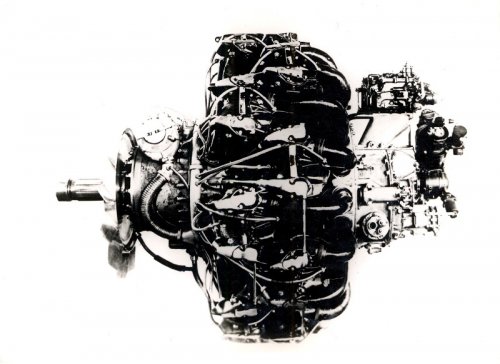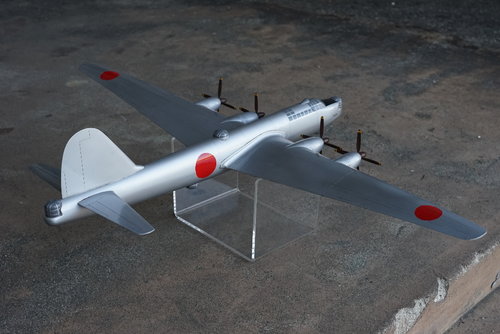blackkite
Don't laugh, don't cry, don't even curse, but.....
- Joined
- 31 May 2007
- Messages
- 8,807
- Reaction score
- 7,678
blackkite said:Hi! Kawasaki Ki-91 long range heavy bomber
Length : 33.35 m
Height : 10.00 m
Span : 48.00 m
Wing area : 224.0 m²
Aspect ratio : 10.3
Wing cross section : Laminar flow wing
Empty weight : 34,000 kg
Gross weight : 58,000 kg
Maximum speed : 570 km/h (at 10,000 m)
Service ceiling : 13,500 m
Time climb to 8,000 m: 20minutes 30seconds
Range : 9,000 km(with 4ton bomb)
Over 10,000km(without bomb)
Engine : Mitsubishi HA214Ru turbo charged air cooling radial 18cylinders(2,500 hp × 4)
Propeller : constant speed, 4 blades, diameter 4.4 m
Fuel :27,500ℓ(the wing contained almost fuel)
Crews : 8
Armaments : 20 mm cannon × 9、Bomb : 8,000 kg(max)
The line which connect inner and outer propeller spinner top in the 3 side view is parallel to the wing leading edge line, but the wind tunnel test model's same line is not parallel to the wing leading edge line.
http://matever.com/archives/ct01complete/_91_1144.html
blackkite said:The line which connect inner and outer propeller spinner top in the 3 side view is parallel to the wing leading edge line, but the wind tunnel test model's same line is not parallel to the wing leading edge line.
Hi! It's clear that we can't find survived official drawing for final Fugaku shape which determined by all Japan Fugaku comittee(member : the IJA, the IJN, Nakajima, Mitsubishi, Kawanishi, etc) still now. So it's impossible to render reliable final Fugaku shape.(I believe that final Fugaku had a slanting cocoon type pressurized cabin( B-29 like wind shield), turbo charged eigines, remote controlled turrets and dropable main tires.)PlanesPictures said:Did we have all clear similar with Fugaku versions? I wanted to render it but I had problems to collect right sources
blackkite said:
Yes I think so,too.windswords said:CherryBlossum,
If you don't mind me answering, that is a G8N. As far as I know they did not ever make the Ki-91, so it was just a "paper project".
windswords said:CherryBlossum,
If you don't mind me answering, that is a G8N. As far as I know they did not ever make the Ki-91, so it was just a "paper project".
windswords said:No not really. Just that I've never seen a picture of a prototype or even a partial construction. According to Ed Dyer's book Japanese Secret Projects a wood mockup was made and inspected by the JAAF in May 1944. The book also says that construction of a prototype was began but the factory was bombed by the Americans in February 1945 which severely damaged the project. With the war situation worsening the project was abandoned to concentrate on fighters.
In "The Xplanes of Imperial Japanese Army & Navy 1924-45" the armament is listed as 20mm x12 but in the drawing there are only x10. :-\blackkite said:http://military.sakura.ne.jp/ac/ki91.htm
武装(armament) 20ミリ機関砲(20mm cannon)×12(連装銃座(coaxial machine cannon)(機首(nose)、前方下部(front under)、上部(upper)、後方下部(aft direction under)、尾部(tail))5、
胴体側面左右各1(fuselage left and right side had one cannon each))、爆弾(bomb)4,000kg~8,000kg搭載

















Wish I had noticed this part ot the thread a few years ago. Do you know when the last Japanese air attack occurred on Saipan B29 base? My father was stationed on Saipan during last year of the war. One of his duties was guarding the fresh water supply. He passed last year and he often spoke about his time on Saipan but made no mention of any air attcks.Saipan B-29 base received several Japanese aircraft attack. And some B-29 were destroyed without Ki-91.
Japanese aircraft which attack Saipan B-29 base were the IJA's Mitsubishi type 97 bomber(97式重爆撃機), the IJN's Mitsubishi type 1 bomber(一式陸上攻撃機) and Mitsubishi Zero fighter(零式艦上戦闘機) from Iou island(硫黄島). They were all Mitsubishi's aircrafts.
Balackkite,
In regards to the Mitsubishi HA42-21 (HA214Ru) you mentioned earlier:
Did the Japanese ever create a reliable turbo super charger? I think I read somewhere that they lacked the skill to work with or possession of metal alloys to make adequate turbine blades that could hold up to prolong use, similar to the problems encountered with the Kikka's jet engines.
]
I don't believe so. I'm sure that the Japanese had the skills. But, fundamentally, they lacked the time to experiment and the economic strength to pursue all desirable powerplant developments at once. They had to prioritize those that offered the best return in the near term--air-cooled radials with modest levels of mechanical supercharging.
